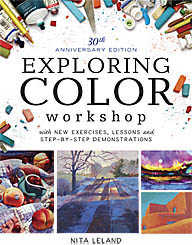Critiquing your own artwork
There comes a time in the life of every artwork when you must stand back and analyze what you've done. Too often artists begin by looking for all the flaws. There's a better way to examine your work.
1. Give the piece time to grow on you. Maybe you're tired of working on it, you've had a bad day, or you're in a hurry. Put it aside and return to it later with a fresh eye.
2. Always look for the good parts first. These are your strengths, the foundation you can build on. Thinking positively makes it easier to handle the negatives.
3. Be realistic about your mistakes. What actual effect do they have on the total piece? Are you making a mountain out of a molehill? Will others notice this "mistake" if you don't point it out to them?
4. Learn from your mistakes. Study them to find effects you can use in another piece. If this one can't be saved, don't quit on it till you have learned all it has to teach you. Experiment with techniques you would hesitate to try on one that is working. At this point, what do you have to lose? As a last resort, save it for collage or just throw it away, no regrets. It's only a piece of paper or canvas.
5. Learn to handle criticism. No one--abslutely no one--agrees on how to judge art. Don't be hurt if someone criticizes your effort. That's one person's opinion. If your artwork is rejected from a show, the same thing applies. One judge's "reject" may be another's "best of show." It happens all the time.
6. Enjoy yourself. How you feel about making art is every bit as important as the product. When you value the experience of making art, the result is a thing of value.
1. Give the piece time to grow on you. Maybe you're tired of working on it, you've had a bad day, or you're in a hurry. Put it aside and return to it later with a fresh eye.
2. Always look for the good parts first. These are your strengths, the foundation you can build on. Thinking positively makes it easier to handle the negatives.
3. Be realistic about your mistakes. What actual effect do they have on the total piece? Are you making a mountain out of a molehill? Will others notice this "mistake" if you don't point it out to them?
4. Learn from your mistakes. Study them to find effects you can use in another piece. If this one can't be saved, don't quit on it till you have learned all it has to teach you. Experiment with techniques you would hesitate to try on one that is working. At this point, what do you have to lose? As a last resort, save it for collage or just throw it away, no regrets. It's only a piece of paper or canvas.
5. Learn to handle criticism. No one--abslutely no one--agrees on how to judge art. Don't be hurt if someone criticizes your effort. That's one person's opinion. If your artwork is rejected from a show, the same thing applies. One judge's "reject" may be another's "best of show." It happens all the time.
6. Enjoy yourself. How you feel about making art is every bit as important as the product. When you value the experience of making art, the result is a thing of value.





0 Comments:
Post a Comment
<< Home